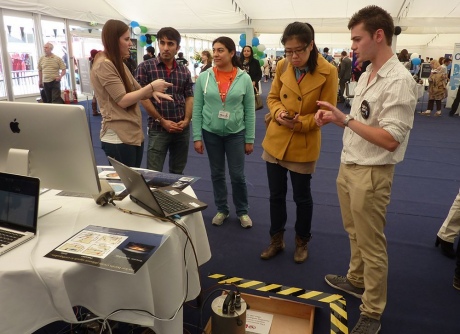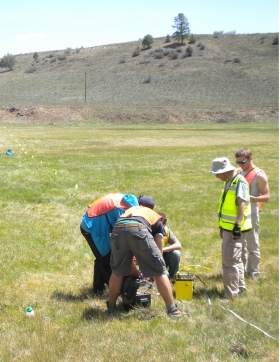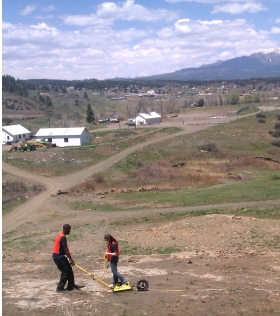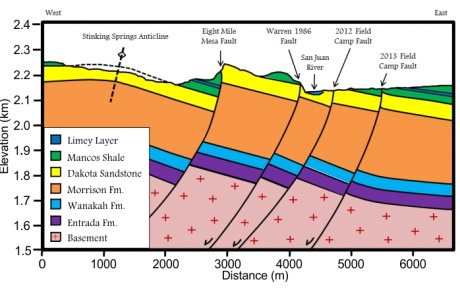June ESE Newsletter

A very proud month for the department with six awards for excellence in teaching, student care, outreach, safety and research.
Publications
Wilkinson, J.J., Simmons, S.F., Stoffell, B. (2013) How metalliferous brines line Mexican epithermal veins with silver. Scientific Reports (Nature Online). doi: 10.1038/srep02057. Article available online.
Helffrich, G., Wookey, J., Bastow, I. (2013) The Seismic Analysis Code: A Primer and User's Guide. Cambridge University Press. Published in September, available to preorder online.
Darbyshire, F. A., Eaton, D. W., Bastow, I. D. (2013) Seismic imaging of the lithosphere beneath Hudson Bay: Episodic growth of the Laurentian mantle keel. Earth and Planetary Science Letters. doi: 10.1016/j.epsl.2013.05.002. Article available online.
Awards
Alex Whittaker was awarded the President & Rector’s Medal for Outstanding Contribution to Teaching Excellence. Imperial College presents annually Awards for Excellence in Teaching for outstanding quality, organisation and presentation. Award winners that are judged to be exceptional can also be awarded a Medal. This is the highest possible award for teaching excellence at Imperial College. As an example of why Alex is so deserving of the Medal is his decision to set up another new 13 day fieldtrip for year 2 students having decided that spending 12 days in the field was not enough already!
Lorraine Craig was awarded Union Fellowship plus a President’s Personal Award at the Imperial College Union Awards Ceremony held on 13th June. She was described as a ‘complete hit with the students’. The President went on to say that ‘Lorraine knows every single one of her students by name and makes it her job to ensure their student experience is second to none’.
Randall Perry has been selected by the British Interplanetary Society judging panel as one of four finalists for one of this year’s Sir Arthur Clarke Awards for Space Achievement - Education and Outreach. The award winners will be announced at the UK Space Conference Dinner in Glasgow on 16th July.
The Loránd Eötvös Award 2013 was presented to Michael King and his co-authors William S Pettitt, Jonathan R Haycox and R Paul Young at the 75th EAGE Conference in London. The award is for their paper ‘Acoustic emissions associated with the formation of fracture sets in sandstone under polyaxial stress conditions’, published in Geophysical Prospecting, volume 60, issue 1, January 2012, pp 93-102.
Pablo Brito-Parada was awarded the Rio Tinto Safety Prize 2012, in recognition of his safety leadership and promotion of a safety first culture. This is the third edition of the £2000 prize and trophy, awarded to individuals or groups within the Rio Tinto Centre for Advanced Mineral Recovery at Imperial College who are judged to make the best contribution to safety within the remit of the centre's work during the previous year.
Peter Fitch has been awarded the London Petrophysical Society’s Woodhouse Award to Young Professionals 2013. This £1000 award aims to encourage the pursuit of excellence in young professional petrophysicists and other geoscientists involved in formation evaluation.
Research Grants
Patrick Farrell has been awarded an EPSRC Early Career Research Fellowship in Engineering (5+3 years) and will be starting in the Mathematical Institute in Oxford in October.
Edward Spencer, PhD student working with Jamie Wilkinson, has been awarded $3500 from the Hugh McKinstry Fund of the Society of Economic Geologists to carry out Re-Os geochronology of molybdenite at the El Teniente porphyry Cu-Mo deposit, Chile.
Zita Martins is a co-proposer in the project “Micro-Mineral interactions in terrestrial Mars analogues: Implications for life detection strategies” (ref. ALW-GO/13-09), which was awarded €253,115.00 from the Netherlands Space Office (NSO). It will cover all the costs of a PhD student (based in The Netherlands), travel, consumables and bench fees.
Impact, Outreach, Media
ESE had their own exhibit at the recent Imperial Festival involving a large group of members of staff and students including Sanjeev Gupta, Emma Passmore, Ian Bastow, Julie Prytulak, Chandra Taposeea, Matt Loader., Tanya Chong, Fanny Garel, Alexander Ellwood, Hayley Meek, Isobel Mackay, Michael Faggetter, Luke Jenkins, Jennifer Quye-Sawyer, Katarina Roele, Tania Buckthorp, Russell Garwood. A big thanks to everyone involved, you did a great job!

Research Activity
James Hammond was invited to speak at the University of Oslo. He presented 'Plume assisted breakup and microcontinent formation: Insights from the Seychelles and Afar, Ethiopia'.
MSc Petroleum Geophysics students undertook two fieldtrips in May and June, under the guidance of Adam Booth and Helmut Jakubowicz, in which they gained hands-on experience with geophysical survey design, acquisition and processing.
On the first trip, hosted at Lasham Airfield (Hampshire, UK), students performed surveys around the Humbly Grove oilfield, where Humbly Grove Energy operate a small production and gas storage facility. The trip culminated in an independent acquisition, in which student temas designed and acquired their own surveys to characterise seismic properties of near-surface chalk. Also included were non-seismic methods (gravity, resistivity, radar and GPS surveying), real-time data quality control, and a lecture from Al Fraser on the local petroleum geology. Imperial PhD students Hussam Busfar, Kenneth Irabor and Akela Silverton contributed their experience, as did staff from the University of Leeds, Swansea University and industrial contractor Geomatrix Earth Science. In the two weeks following the trip, students were guided through data processing by visiting lecturer Monika Ivandic (Uppsala University, Sweden).
The second trip was held in conjunction with Colorado School of Mines in the town of Pagosa Springs (southern Colorado, USA); Imperial’s teaching team was bolstered by Eleanor Oakley (MSc Petroleum Geophysics, 2011-2012) and PhD student Jorge de la Guzman Torre. 
In two weeks of multi-disciplinary acquisition, student surveys helped characterise the plumbing of a geothermal resource, targeted for development by a Pagosa Springs interest group. Students experienced seismic acquisition with an industrial vibratory source, donated by CGG. In the following two weeks, they then processed their data and presented observations back at the Mines campus.
 The contribution of this trip to the student learning experience was recognised by the Society for Exploration Geophysics, and Imperial College was awarded $7000 towards trip expenses.
The contribution of this trip to the student learning experience was recognised by the Society for Exploration Geophysics, and Imperial College was awarded $7000 towards trip expenses.
“Working out of doors, trying different techniques every day, collecting data on the earth and seeing the results, were really exciting,” says MSc Petroleum Geophysics student Ezgi Emir. “It encouraged me to work in the field in the future. The connection between the field and the theory made me understand my job in an extended perspective.”
Above: MSc Petroleum Geophysics students perform geophysical acquisitions in Pagosa Springs, USA. Electrical Resistivity Tomography (R. Metcalfe). Ground Penetrating Radar (A. Booth).
Below: Geological cross-section and seismic data through the Pagosa Springs geothermal system, produced and processed during the MSc fieldtrip (L. Meams).


Article text (excluding photos or graphics) © Imperial College London.
Photos and graphics subject to third party copyright used with permission or © Imperial College London.
Reporter
Press Office
Communications and Public Affairs
- Email: press.office@imperial.ac.uk
